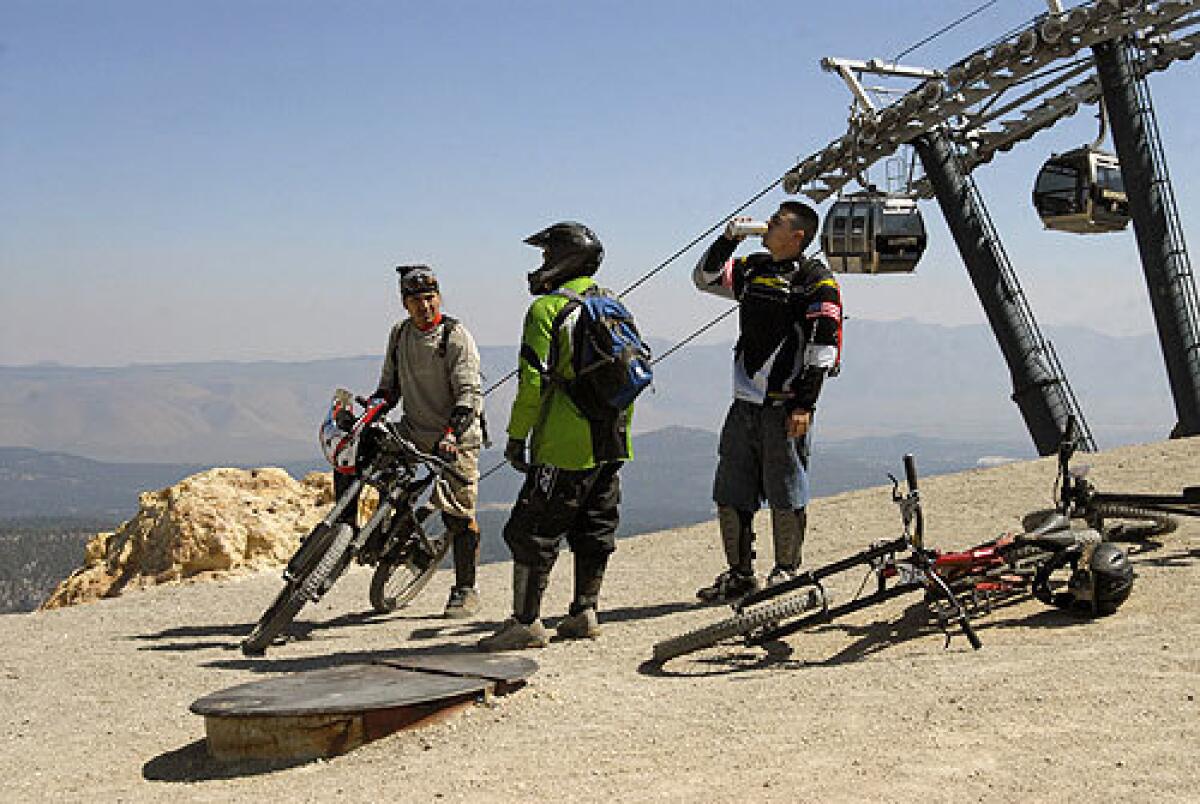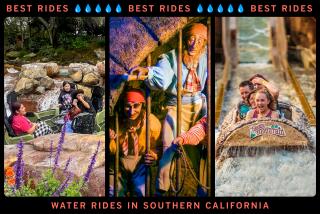Now, snow is optional

FLYING off a rocky buttress, the mountain biker soars through the air, experiencing a few seconds of adrenaline-heightened sensory awareness before coming back to earth -- or in this case a wooden ramp -- with a bike-jarring thump.
The rider is Mark Hendrickson, a former pro mountain bike racer who designed the jump, one of four big drops on the new trail, Techno Rock. After the drops, the trail plunges into the dirt walls of a snowboarding half-pipe and finishes at Kamikaze Park, where riders can get vertical on a metal wall.
The extreme ride is one of three new advanced trails at Mammoth Mountain Ski Area’s bike park in California’s Eastern Sierra.
“It feels like you’re dropping off the face of the Earth as you come through the trees and get big air and go weightless,” says Hendrickson.
“You have a couple of seconds to think about what you’ve done before you stick your landing and nuke across the ski run and get set up for the next drop.”
Ski resorts have been expanding their seasons over the last 20 years by building mountain bike trails and using lifts to transport bikes and riders to the tops of their mountains in summertime. While riders were happy at first to cruise more gentle trails that zigged across the fall line, soon many wanted more gravity-assisted stimulation down the ski runs.
Now resorts are amping up the natural terrain with artificial obstacles that provide added thrills.
The Techno Rock trail that Hendrickson helped design is part of that trend. The man-made jumps, walls and berms echo the concept of wintertime terrain parks where snowboarders skirt Newton’s laws on rails, half-pipes, boxes and jumps that provide more adventure than natural snow-covered slopes. The bike park, now closed for the upcoming winter season, will reopen in June.
“The evolution of mountain bike riding has followed the same curve as snowboarding,” says Kirstin Cattell, a spokeswoman for the Northstar-at-Tahoe Resort. “First it was cross-country riding on the trails, now terrain parks are getting much more popular.”
At Mammoth Mountain, spokeswoman Joani Lynch says, “The improvement in bike technology has made this kind of advanced terrain accessible to more riders. We’re building these trails because there is a market for them and it helps strengthen our year-round business.”
Mountain bikers who negotiate such parks have even purloined some of the vocabulary of snowboarders -- while adding new terms. “Railing” is riding around a bend as if in a groove and “hucking” means launching off a big drop. If a rider doesn’t stick the landing after hucking, he or she becomes a “lawn dart.” And as a clue that riders should be prepared for sudden impacts, there are a number of synonyms for crashing -- “carcassing” and “wadding” among them.
The parks have also adopted ski trail rating symbols. Green circle trails are for beginners, blue squares are for intermediate riders, and black diamond and double black diamond trails are for experts. More difficult trails are also marked with one to four downward-pointing arrows. A single arrow marks a bump riders can probably roll over; four arrows means a big drop and mandatory air time.
The new artificial challenges for mountain bikers are part of the evolution of an outlaw branch of the sport called freeriding that started on the rainy coast of British Columbia.
--
Carving out their own space
Mountain biking developed on the trails and fire roads that crisscross the grassy, rolling hills of Marin County in Northern California. But when riders in the north shore area of Vancouver, Canada, tried mountain biking, they found the local woods filled with marshy areas and obstacles like stumps, deadfall and rocks that made riding a bike nearly impossible. They responded by building wooden bridges over the muddy areas and rode on downed timber. These structures, often built without permission from landowners, evolved into jumps, teeter-totters and other challenges that required advanced bike-handling skills and a willingness to become airborne.
The new trails broke bicycles that weren’t designed for the stress of landing big jumps. Manufacturers came up with new freeride mountain bikes, beefier than the 25-pound cross-country bikes designed to be easily pedaled uphill on natural terrain, and lighter than 45-pound one-way downhill bikes meant only to be carried uphill on a ski lift before bombing back down a steep run.
Advances in bike equipment have helped spread the north shore freeride movement south. New bikes have much more suspension travel, allowing the riders to cruise rougher trails without going over the bars. Hydraulic disc brakes, like on a Porsche, replace traditional bicycle rim brakes and allow riders to stop more effectively without overheating wheel rims on steep descents.
“Some of the bikes are like motorcycles without motors. They can pretty much bowl over anything,” says Bert Hand on the 12-minute gondola ride with his bike to the top of 11,053-foot-high Mammoth Mountain. On the gondola, Hand and his buddies can see the jagged peaks of the Minarets in the Ansel Adams Wilderness and look down and watch riders popping off the big drops on Techno Rock.
--
Designed to thrill, not injure
It would seem that more challenging trails would produce more injuries to riders, but that doesn’t seem to be the case.
Mountain bikers can consult the trail map ratings and select what is within their ability. Jenni Kincheloe, a Mammoth local, says, “People who don’t know what they are doing won’t be going down those trails. And you can always get off and walk.”
Bike park designers also make sure that riders know what they’re in for at the beginning of advanced trails.
The new, nearly 2-mile long LiveWire trail at Northstar-at-Tahoe Resort’s bike park has more than 40 jumps, big tall berms and is irrigated with water from the snowmaking system to keep the trail smooth, fast and grippy.
But at the beginning of the trail riders have to ride across a log to get onto the trail and see a sign that warns them that if they cannot handle this feature they do not belong on the trail.
“It is a gnarly sport for sure,” says Hendrickson, who has also been a ski patroller in the winter. “But riders in general are taking better care of themselves than skiers or snowboarders. They know they are going to crash, so they’re wearing the protective gear. When someone does crash really hard, that’s when we come and pick them up.”
Some riders at the mountain look like “Star Wars” imperial stormtroopers ready to zap Luke Skywalker.
Besides wearing the full-face helmets that are similar but lighter than those worn by motorcycle racers, many mountain bikers get Darth Vadered in padded black plastic armor that can cover knees, shins, elbows, chest, spine and hips. The protective gear is available for rent at Mammoth’s bike park.
“I always tell people to put on as much plastic on you feel comfortable with,” says Hendrickson. “It’s always nicer to lose plastic than skin.”
Dr. Chris Hummel, director of the emergency department at Mammoth Hospital, says that he hasn’t seen an increase in mountain bike-related injuries over the last year. Most of the bike injuries treated at the ER are moderate abrasions.
“The fact that everyone is wearing a helmet is probably why we see so few serious injuries,” says Dr. Hummel.
Riders on less difficult trails are also armoring up, including beginners.
In addition to a helmet, Hendrickson advises new riders to wear shin/knee and elbow pads.
“It hurts when you take a layer of skin off and then have to take a shower,” he says.
Gina Chironif rides the intermediate trails and avoids the big drops at Mammoth. But she still wears knee and elbow pads in addition to a full face helmet. She says if you fall without wearing pads, “you look like your husband has been beating you.” Especially if you become a lawn dart.
More to Read
Sign up for The Wild
We’ll help you find the best places to hike, bike and run, as well as the perfect silent spots for meditation and yoga.
You may occasionally receive promotional content from the Los Angeles Times.






